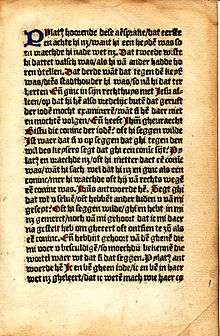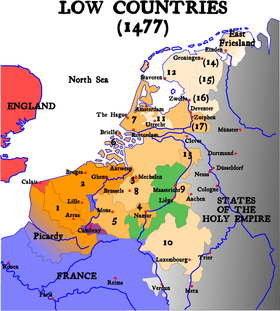Fasciculus mirre

Fasciculus mirre is a Germanic devotional book that was popular in the Low Countries during the first half of the sixteenth century. The text contains meditations on the life of Jesus Christ, most notably the Passion.[1][2] Its Latin title (meaning "a bundle of myrrh" in English)[3] comes from the first chapter of Canticum Canticorum: "Fasciculus Myrrhae dilectus meus mihi inter ubera mea commorabituris."[4] Fasciculus mirre is often sometimes spelled as Fasciculus myrre, or myrrhæ, and can also be referred to by an English title, On the Life of Christ.[5] The earliest known printed version dates to approximately 1500 CE in the Dutch city of Delft.[6]
Background
Fasciculus mirre was first compiled by an anonymous Franciscan in the German city of Cologne, although the exact date of its original composition is unknown.[1] During a time when Europe was on the eve of the Protestant Reformation, the pocket-sized text was convenient for those who could carry it around with them everywhere, reading it throughout the day and embracing the spiritual power it was believed to have embodied.[7]

Following the expansion of both the printing press and the Reformation during the first half of the sixteenth century, various editions of the book were widely circulated throughout the Low Countries while the region was under the control of Charles V and the Holy Roman Empire. Between 1518 and 1550, twenty separate editions of Fasciculus mirre were printed in the bustling, mercantile hub of Antwerp,[8] a city which was becoming an epicenter of commercial printing as well as a popular safe-haven for non-Catholic religious movements such as Calvinism and Lutheranism.[9]
Dutch Printed Editions, 1500-1578
- 1500: Delft - Roelant Bollaert[6][10]
- 1504: Antwerp - Willem Vorsterman[11]
- 1517: Delft - Hugo Jansz (or Janszoon) van Woerden, edited by Matthias Weynsen (or Weijnsen) (or Matthijs Wentsen)[1][12]
- 1518: Antwerp - Henrick van Eckert Homberch, edited by Matthias Weynsen[1][13]
- 1519: Antwerp - Willem Vorsterman, edited by Matthias Weynsen[1][14]
- 1519: The Hague - Hugo Jansz van Woerden[1][15]
- 1520: Antwerp - Heyndrick Peetersen van Middelburch, edited by Matthias Weynsen[16]
- 1526: Antwerp - Symon Cock voor (for) Roelant Bollaert, edited by Matthias Weynsen[17]
- 1527: Antwerp - Jan I van Ghelen[18]
- 1527: Antwerp - Willem Vorsterman[19]
- 1529: Antwerp - Symon Cock, edited by Matthias Weynsen[20]
- 1534: Antwerp - Willem Vorsterman[21]
- 1535: Antwerp - Willem Vorsterman[22]
- 1537: Antwerp - Hansken van Liesvelt[23]
- 1537: Antwerp - Heyndrick Peetersen van Middelburch[24]
- 1538: Antwerp - Heyndrick Peetersen van Middelburch[25]
- 1539: Antwerp - Symon Cock[26]
- 1540: Antwerp - Jan I van Ghelen[27]
- 1540: Antwerp - Heyndrick Peetersen van Middelburch[28]
- 1543: Antwerp - Willem Vorsterman, edited by Matthias Weynsen[29]
- 1543: Antwerp - Jacob van Liesvelt[30]
- 1544: Antwerp - Heyndrick Peetersen van Middelburch, edited by Matthias Weynsen[31]
- 1546: Leiden - Peter Janszoon, edited by Matthias Weynsen[32]
- 1548: Antwerp - Jacob van Liesvelt, edited by Matthias Weynsen[33]
- 1550: Antwerp - Heyndrick Peetersen van Middelburch, edited by Matthias Weynsen[34]
- 1550: Unknown Location - Unknown Printer (woodcuts by Bollaert?)[35]
- 1554: Leiden - Peter Janszoon, edited by Matthias Weynsen[36]
- 1565: Antwerp - Peeter van Keerberghen, edited by Matthias Weynsen[37]
- 1565: Leiden - Dierick Gerridt Horst voor Peeter van Keerberghen, edited by Matthias Weynsen[38]
- 1569: Antwerp - Jan II van Ghelen[39]
- 1572-78: Antwerp - Symon Cock voor Roelant Bollaert[40]
English Jesuit Version
In 1632-33, the book was translated into English by the Jesuit priest John Falconer. Falconer published it as Fasciculus myrrhæ. Or a briefe treatise of our Lord and Sauiours passion. Written by the R. Fa. I. F. of the Society of Iesus.[41]
Modern Significance
Today, Fasciculus mirre continues to be a curious obscurity in the vast realm of devotional literature and incunabula. Fully intact copies are extremely rare, but can be found through the Universal Short Title Catalogue database. Typically, only leaves (single pages with text on each side) can be found within the United States, either in museums or in University Libraries of Special Collections, as such leaves are prized among collectors of rare medieval manuscripts, incunabula, and post-incunabula.
Examples of Leaves Housed at University Libraries in the United States
- Indiana University of Pennsylvania Indiana, Pennsylvania
- University of South Carolina Columbia, South Carolina
- University of Missouri Columbia, Missouri
- Western Michigan University Kalamazoo, Michigan
- Portland State University (Link available November 2016) Portland, Oregon
See also
- Book of hours
- Block books
- Incunable
- Global spread of the printing press
- List of printers in the Southern Netherlands
- The Protestant Reformation
- Habsburg Netherlands
- Guild of Saint Luke
Notes
- 1 2 3 4 5 6 Pallarés Jiménez, Miguel Ángel. “Algunas Reflexiones Sobre El Inicio de la Tipografía en Zaragoza y Aragón: Cambios Pervivencias en la Transición del Códice al Impreso.” Universidad de Zaragoza (2002): 114. http://ifc.dpz.es/recursos/publicaciones/32/44/05pallares.pdf
- ↑ Roest, Bert. "Franscicans Between Observance and Reformation: The Low Countries (ca. 1400-1600)." Franciscan Studies 63 (2005): 429-31.
- ↑ "Google Translate: Fasciculus mirre".
- ↑ Roest, Bert. "Franscicans Between Observance and Reformation: The Low Countries (ca. 1400-1600)." Franciscan Studies 63 (2005): 431.
- ↑ Indiana University of Pennsylvania Special Collections and University Archives. Pages from the Past: Original leaves from Rare Books and Manuscripts: Manuscript Group 178 (Jan. 29, 2015): 7. http://libs0500.library.iup.edu/depts/speccol/All%20Finding%20Aids/Finding%20aids/MG%20or%20Col/MG178Word.pdf
- 1 2 Pages from the Past: Original Leaves from Rare Books and Manuscripts. Portfolio Set I: History of the Written Word. Washington, D.C.: Foliophiles, 1964.
- ↑ Roest, Bert. "Franscicans Between Observance and Reformation: The Low Countries (ca. 1400-1600)." Franciscan Studies 63 (2005): 428-33.
- ↑ "Universal Short Title Catalogue, hosted by the University of Saint Andrews". Retrieved May 17, 2016.
- ↑ Matthijs de Lok. Review of Marnef, Guido, Antwerp in the Age of Reformation: Underground Protestantism in a Commercial Metropolis 1550-1577. H-Urban, H-Net Reviews. January, 1998.http://www.h-net.org/reviews/showrev.php?id=1619. Retrieved May 17, 2016.
- ↑ "Biblio.com--EARLY PRINTED LEAF: from Fasciculus Mirre by Matthijs Weynsen, printed in Delft by Roelant Bollaert [6 March, 1517 or 1500?]. A German work on the life of Christ. 26 lines".
- ↑ "Antwerpen, Willem Vorsterman, 1504-44". USTC, University of St. Andrews.
- ↑ "Delft, Hugo Jansz van Woerden, 1517". USTC, University of St. Andrews.
- ↑ "Antwerpen, Henrick Eckert van Homberch, 1518". USTC, University of St. Andrews.
- ↑ "Antwerpen, Willem Vorsterman, 1519". USTC, University of St. Andrews.
- ↑ "Den Haag, Hugo Jansz van Woerden, 1519". USTC, University of St. Andrews.
- ↑ "Antwerpen, Heyndrick Peetersen van Middelburch, 1520-49". USTC, University of St. Andrews.
- ↑ "Antwerpen, Symon Cock voor Roelant Bollaert, 1526". USTC, University of St. Andrews.
- ↑ "Antwerpen, Jan I van Ghelen, [1527]". USTC, University of St. Andrews.
- ↑ "Antwerpen, Willem Vorsterman, [1527]". USTC, University of St. Andrews.
- ↑ "Antwerpen, Symon Cock, 1529". USTC, University of St. Andrews.
- ↑ "Antwerpen, Willem Vorsterman, 1534". USTC, University of St. Andrews.
- ↑ "Antwerpen, Willem Vorsterman, [1535]". USTC, University of St. Andrews.
- ↑ "Antwerpen, Hansken van Liesvelt, [1537]". USTC, University of St. Andrews.
- ↑ "Antwerpen, Heyndrick Peetersen van Middelburch, [1537]". USTC, University of St. Andrews.
- ↑ "Antwerpen, Heyndrick Peetersen van Middelburch, 1538". USTC, University of St. Andrews.
- ↑ "Antwerpen, Symon Cock, 1539". USTC, University of St. Andrews.
- ↑ "Antwerpen, Jan I van Ghelen, 1540". USTC, University of St. Andrews.
- ↑ "Antwerpen, Heyndrick Peetersen van Middelburch, 1540". USTC, University of St. Andrews.
- ↑ "Antwerpen, Willem Vorsterman, 1543". USTC, University of St. Andrews.
- ↑ "Antwerpen, Jacob van Liesvelt, 1543". USTC, University of St. Andrews.
- ↑ "Antwerpen, Heyndrick Peetersen van Middelburch, 1544". USTC, University of St. Andrews.
- ↑ "Leiden, Peter Janszoon, 1546". USTC, University of St. Andrews.
- ↑ "Antwerpen, vid. Jacob van Liesvelt, [1548]". USTC, University of St. Andrews.
- ↑ "Antwerpen, vid. Heyndrick Peetersen van Middelburch, [1550]". USTC, University of St. Andrews.
- ↑ Indiana University of Pennsylvania Special Collections and University Archives. Pages from the Past: Original leaves from Rare Books and Manuscripts: Manuscript Group 178 (Jan. 29, 2015): 6. http://libs0500.library.iup.edu/depts/speccol/All%20Finding%20Aids/Finding%20aids/MG%20or%20Col/MG178Word.pdf
- ↑ "Leiden, Peter Janszoon, 1554". USTC, University of St. Andrews.
- ↑ "Antwerpen, Peeter van Keerberghen, 1565". USTC, University of St. Andrews.
- ↑ "Leiden, Dierick Gerridt Horst voor Peeter van Keerberghen (Antwerpen), 1565". USTC, University of St. Andrews.
- ↑ "Antwerpen, Jan II van Ghelen, 1569". USTC, University of St. Andrews.
- ↑ "Antwerpen, Symon Cock voor Roelant Bollaert, 1572-78". USTC, University of St. Andrews.
- ↑ "Fasciculus myrrhæ. Or a briefe treatise of our Lord and Sauiours passion. Written by the R. Fa. I. F. of the Society of Iesus". Universiteitsbibliotheek Gent. Retrieved May 20, 2016.
Further reading
- Roest, Bert. "Franscicans Between Observance and Reformation: The Low Countries (ca. 1400-1600)." Franciscan Studies 63 (2005): 409-42.
- Stock, Jan Van Der. Printing Images in Antwerp: The Introduction of Printmaking in a City: Fifteenth Century to 1585. Studies in Prints and Printmaking; v. 2. Rotterdam: Sound & Vision Interactive, 1998.
- Vervliet, Hendrik D. L. Sixteenth Century Printing Types of the Low Countries. Amsterdam: Menno Hertzberger, 1968.
- Wijsman, Henri Willem, Kelders, Ann, and Sutch, Susie Speakman. Books in Transition at the Time of Philip the Fair: Manuscripts and Printed Books in the Late Fifteenth and Early Sixteenth Century Low Countries. Burgundica; 15. Turnhout, Belgium: Brepols, 2010.
External links
- The Universal Short Title Catalogue, hosted by the University of Saint Andrews, is "a collective database of all books published in Europe between the invention of printing and the end of the sixteenth century," which includes a list of 29 different editions of Fasciculus mirre that were printed in various Dutch cities between 1504 and 1578.
- Preservation Measures: Pages from the Past. Miami University (Oxford, Ohio), detailed information on The Foliophiles, Inc. and the practice of biblioclasty (book-breaking).